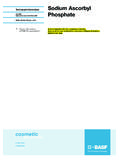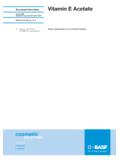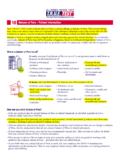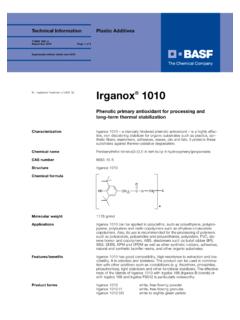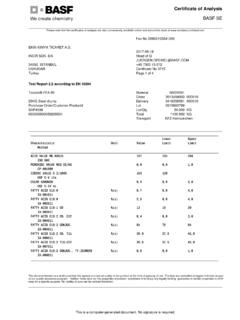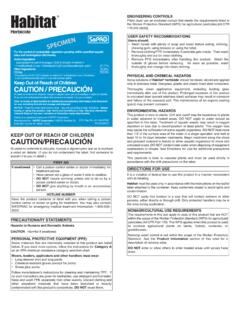Transcription of Retinol - Dr. Baumann's Exclusive Bionome Skincare
1 Technical Information Retinol May 2005 Retinol 50 C. Supersedes issue dated August 2004. Retinol 15 D. MEMKS 040801e-00/Page 1 of 10. Retinol 10 S. = Registered trademark Active ingredient for the cosmetics industry. Counteracts skin aging of BASF Aktiengesellschaft and improves the appearance of UV-damaged skin. Hair Care Skin Care Oral Care MEMKS 040801e-00 May 2005 Page 2 of 10 Retinol Structural formula Synonyms all-trans- Retinol , vitamin A alcohol Molecular formula C20H30O. Molar mass g/mol INCI name Retinol CAS-No. 68-26-8 ( Retinol ). Retinol 50 C: 9005-64-5 (Polysorbate 20). Retinol 15 D: 65381-09-1, 73398-61-5 (caprylic/capric triglyceride).
2 Retinol 10 S: 8001-22-7 (Soybean [Glycine Soya]Oil). Grades available Retinol 15 D Retinol 10 S Retinol 50 C. Appearance Yellow oil that Yellow oil, with Yellow oil, with may crystallize crystals at low crystals at low at temperatures temperatures temperatures below 0 C. Solvent Caprylic/Capric- Soybean oil Polysorbate 20. Triglyceride Assay ca. 15% ca. 10% ca. 50%. Stabilizer ca. 1% BHT ca. 1% BHT ca. BHT. system and ca. 1% BHA. Specification Retinol 15 D. Parameter Requirement Method Assay - Retinol 500,000-530,000 IU/g 05 - BHT 05 Purity - all-trans- Retinol in total Retinol 95% 05 - cis-isomers in total Retinol 5% 05 Identity Passes test 05 Retinol 10 S.
3 Parameter Requirement Method Assay - Retinol 330,000-370,000 IU/g USP mod. Meth. 05 - BHT 05 Purity - all-trans- Retinol in total Retinol 95% 05 - cis-isomers in total Retinol 5% 05 Identity Passes test USP 23 +B, 05 05 2. MEMKS 040801e-00 May 2005 Page 3 of 10 Retinol Retinol 50 C. Assay - Retinol 1,425,000-1,650,000 05 IU/g Content - BHT 05 - BHA 05 - Residual solvent, heptane < 2,000 ppm 05 Purity - all-trans- Retinol in total Retinol 95% 05 - Cis-isomers in total Retinol 5 05 Idendity Passes test 05 05 Applications Retinol is an active ingredient for sophisticated cosmetic skin care products. It is the most effective substance for the care of aging and UV-damaged skin.
4 Most of the signs of aging (wrinkles, lines, and irregular color, lost elasticity). are avoidable. They are almost entirely the result of the way we live and the environment we live in. Retinol accelerates mitosis, increases enzyme activity, and normalizes keratinisation, which improves and normalizes the cell renewal process. The skin regenerates itself throughout its depth. The epidermis and dermis grow thicker, and the skin becomes more elastic. This reduces wrinkles and lines in number, area, length and width. The skin becomes elastic, fresh and adequately supplied with moisture. It looks clearer and has a healthy color.
5 Blemishes in the skin become less conspicuous. Efficacy The effects of topically applied Vitamin A have been confirmed in a large number of studies. Caldera demonstrated the absorption of Vitamin A through the skin in an in-vivo study. He found a significant increase in blood levels of Vitamin A in his patients after application of an ointment containing Vitamin A ( , , , , The Cutaneous Absorption of Vitamin A, Dev. Pharmacol. Ther. 7, suppl. 1, 213-217 (1984)). In a survey, Kretz mentions several studies that describe an increased rate of mitosis in rats and mice, a thickening of the epidermis in mice, an increase in the collagen content in the dermis of mice and increased skin elasticity in test persons as a result of the topical application of Vitamin A ( ; Vitamin A in der Kosmetik; S FW-Journal, 119, 21-24 (1993)).
6 In a clinical study involving 30 test persons, Bertin demonstrated that Retinol applied in a cream increases the biological elasticity of the skin and reduces the depth of wrinkles (C. Bertin et al. Retinol + Melibiose: An Innovative Anti-Aging Association, 20th ISFCC Congress, P 058, 1-7 (1998)). Safety: A Safety Data Sheet is available for Retinol . The substance may irritate the skin and was found to have a sensitizing potential in animals. Retinol was found to be teratogenic when administered to animals at unphysiologically high oral doses. There is some indication for a possible connection between high intake of this substance during pregnancy and birth deformities in humans.
7 The recommended concentrations given below are based on a risk assessment based on exemplary topical exposure scenarios for cosmetic products as given in the European Union by the recommendations of the Scientific Committee of Cosmetology and Non Food Products (SCCNFP) (Notes of Guidance, 2000). The calculations result in the doses given below with a Margin of Safety of 1000. and higher. This safety factor is suggested for substances, which show severe critical effects such as teratogenicity in animal experiments for the acceptable daily intake according to the WHO risk assessment procedure (1994). 3. MEMKS 040801e-00 May 2005 Page 4 of 10 Retinol We emphasize that the dermal bioavailability of Retinol and consequently the potential toxicity is dependant on the composition of the formulation of the final product.
8 Thus the dermal absorption rate should be determined with the respective product. The calculations below can therefore only be considered as examples. The manufacturer of the final cosmetic product has to do in any case an own safety evaluation based on the data of his market formulation. Product Face Cream Hand Cream Body Lotion A Conc. of Retinol in formulation of the finished product B Amount of finished product g g 8g per application C Number of application(s) 2 2 1. per day D Exposure of finished g g 8g product per day (B x C = D). E Exposure of Retinol per day mg mg mg (A x D = E). F Exposure Retinol /kg (50 kg 16 g/kg 16 g/kg 16 g/kg body weight).
9 (E / 50 = F). G estimated bioavailability 10% 10% 10%. H Systemic exposure (SE) g/kg g/kg g/kg (F x G = H). I NOAEL (No observed 2250 g/kg 2250 g/kg 2250 g/kg adverse effect level). K Margin of Safety (NOAEL/SE) 1400 1400 1400. (I / H = K). NOAEL: No Observed Adverse Effect Level in microgram per kilogram bodyweight from a prenatal toxicity study in monkeys with retinyl palmitate. Recommended concentrations Retinol , % assumed applications per day Face cream 2. Night cream 1. Hand cream 2. Body lotion 1. After-sun Face cream 1. After-sun Body lotion 1. Retinol can irritate the skin. Due to the fact that Asian skin is more sensitive, we recommend to stay on the low side of recommended concentrations for products for the Asian market MEMKS 040801e-00 May 2005 Page 5 of 10 Retinol Solubility Retinol is miscible with fats and oils.
10 Technical properties and handling Retinol is a crystalline solid that is sensitive to oxygen, heat, light and heavy metals. It is therefore dissolved in oils, filled under nitrogen, stabilized with antioxidants and stored in aluminum cans at low temperatures. Retinol can crystallize out at low temperatures, but the crystals can be redissolved by heating the can to 50 C. The time needed to redissolve Retinol varies and is dependent on the temperature and time of storage. It is therefore impossible to give exact advice how long it takes to redissolve. Stability tests have shown that the unopened container can be heated to 50 C for up to 5.


